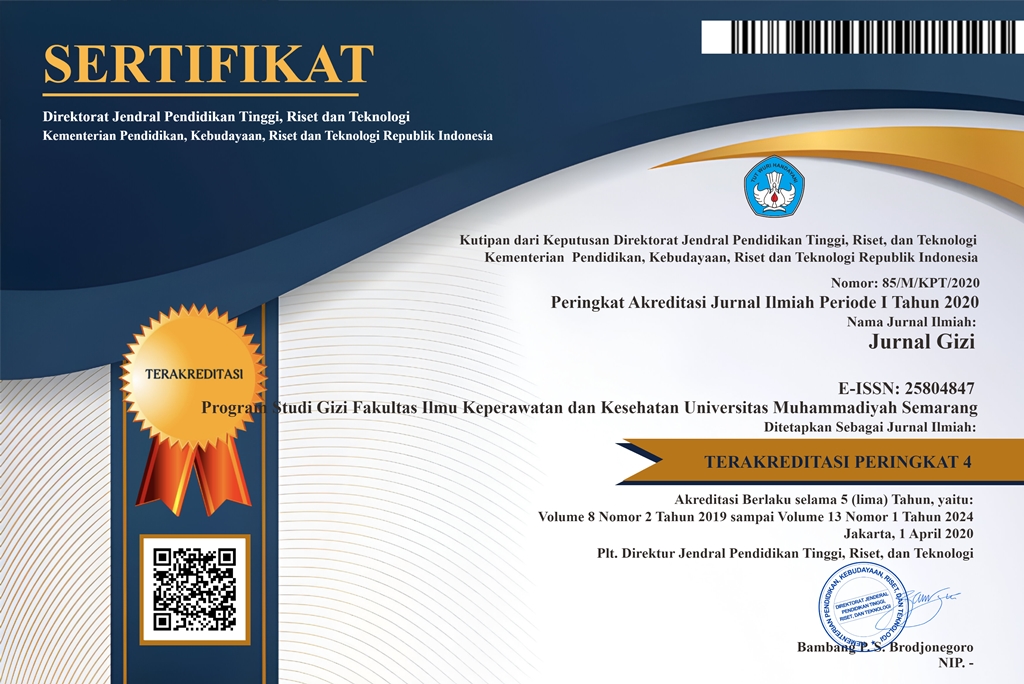Asupan Zink, Riwayat ISPA dan Pengeluaran Pangan Sebagai Faktor Resiko Stunting Pada Anak Usia 2-5 tahun di Kota Semarang
(1)
(2)
(3)
(*) Corresponding Author
Abstract
Prevalence of stunting in Central Java 2014 amounted 33,9% and in Semarang 4,03%. Stunting is caused by direct and indirect factors. Direct factors include zinc intake and history of ISPA. Zinc deficiency caused by immunity to infection and decrease resulting in growth
retardation. Indirect factors including low food expenditure can result in a lack of fulfillment of nutritional intake in children. The purpose of this study was to analyze the low adequacy levels of zinc, history of ISPA and low food expenditure as risk factors of stunting among children aged 25 years in Semarang.This was a case-control study with a sample of 71 cases (stunting) and 71 controls (not stunting), using purposive sampling technique. Zinc intake data was obtained with the semi-quantitative food frequency questionnaire (SQ-FFQ), while data on history of ISPA and
food expenditure were obtained through a questionnaire and interview. Data analysis was performed using chi-square test and multivariate logistic regression method
The result of univariate analysis showed that the average of zinc intake was 3,51±0,07 mg, subjects with a history of ISPA of 59,8%, average food expenditure Rp 316.372±16.878. The result of the bivariate analysis showed that low level of zinc (p=0,001; OR=9,2; CI=2-42,1) and a
history of ISPA (p=0,01; OR=2.4; CI=1,2-4,8) were risk factors for stunting, while the low level of food expenditure (p=0,31) is not a stunting risk factor. Multivariate analysis showed that the risk factors that most affect of stunting was low level of zinc (p=0,01; OR=7,5; CI=1,6-35,1). Low level of zinc and history of ISPA are risk factors of stunting in children aged 2-5 years old in Semarang.
Keywords: Stunting, children, risk factors, zinc, ISPA
retardation. Indirect factors including low food expenditure can result in a lack of fulfillment of nutritional intake in children. The purpose of this study was to analyze the low adequacy levels of zinc, history of ISPA and low food expenditure as risk factors of stunting among children aged 25 years in Semarang.This was a case-control study with a sample of 71 cases (stunting) and 71 controls (not stunting), using purposive sampling technique. Zinc intake data was obtained with the semi-quantitative food frequency questionnaire (SQ-FFQ), while data on history of ISPA and
food expenditure were obtained through a questionnaire and interview. Data analysis was performed using chi-square test and multivariate logistic regression method
The result of univariate analysis showed that the average of zinc intake was 3,51±0,07 mg, subjects with a history of ISPA of 59,8%, average food expenditure Rp 316.372±16.878. The result of the bivariate analysis showed that low level of zinc (p=0,001; OR=9,2; CI=2-42,1) and a
history of ISPA (p=0,01; OR=2.4; CI=1,2-4,8) were risk factors for stunting, while the low level of food expenditure (p=0,31) is not a stunting risk factor. Multivariate analysis showed that the risk factors that most affect of stunting was low level of zinc (p=0,01; OR=7,5; CI=1,6-35,1). Low level of zinc and history of ISPA are risk factors of stunting in children aged 2-5 years old in Semarang.
Keywords: Stunting, children, risk factors, zinc, ISPA
Full Text:
PDFArticle Metrics
Abstract view : 1798 timesPDF - 840 times
DOI: https://doi.org/10.26714/jg.7.1.2018.%25p
Refbacks
- There are currently no refbacks.
Diterbitkan oleh: Program Studi Gizi (D3 dan S1)
Fakultas Ilmu Keperawatan dan Kesehatan
Universitas Muhammadiyah Semarang
Sekretariat: Jl. Kedungmundu Raya No. 18 Semarang
Contact Person : Hapsari Sulistya Kusuma, S.Gz, M.Si (+62 85 6 41 536 553)

This work is licensed under a Creative Commons Attribution 4.0 International License.









.png)
.png)